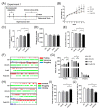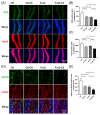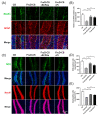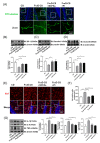Short-Chain Fatty Acids Ameliorate Depressive-like Behaviors of High Fructose-Fed Mice by Rescuing Hippocampal Neurogenesis Decline and Blood-Brain Barrier Damage
- PMID: 35565849
- PMCID: PMC9105414
- DOI: 10.3390/nu14091882
Short-Chain Fatty Acids Ameliorate Depressive-like Behaviors of High Fructose-Fed Mice by Rescuing Hippocampal Neurogenesis Decline and Blood-Brain Barrier Damage
Abstract
Excessive fructose intake is associated with the increased risk of mental illness, such as depression, but the underlying mechanisms are poorly understood. Our previous study found that high fructose diet (FruD)-fed mice exhibited neuroinflammation, hippocampal neurogenesis decline and blood-brain barrier (BBB) damage, accompanied by the reduction of gut microbiome-derived short-chain fatty acids (SCFAs). Here, we found that chronic stress aggravated these pathological changes and promoted the development of depressive-like behaviors in FruD mice. In detail, the decreased number of newborn neurons, mature neurons and neural stem cells (NSCs) in the hippocampus of FruD mice was worsened by chronic stress. Furthermore, chronic stress exacerbated the damage of BBB integrity with the decreased expression of zonula occludens-1 (ZO-1), claudin-5 and occludin in brain vasculature, overactivated microglia and increased neuroinflammation in FruD mice. These results suggest that high fructose intake combined with chronic stress leads to cumulative negative effects that promote the development of depressive-like behaviors in mice. Of note, SCFAs could rescue hippocampal neurogenesis decline, improve BBB damage and suppress microglia activation and neuroinflammation, thereby ameliorate depressive-like behaviors of FruD mice exposed to chronic stress. These results could be used to develop dietary interventions to prevent depression.
Keywords: blood-brain barrier; depressive-like behaviors; high-fructose diet; neurogenesis; short-chain fatty acids; stress resilience.
Conflict of interest statement
The authors declare no conflict of interest.
Figures






References
-
- Santomauro D.F., Herrera A.M., Shadid J., Zheng P., Ashbaugh C., Pigott D.M., Abbafati C., Adolph C., Amlag J.O., Aravkin A.Y., et al. Global prevalence and burden of depressive and anxiety disorders in 204 countries and territories in 2020 due to the COVID-19 pandemic. Lancet. 2021;398:1700–1712. doi: 10.1016/S0140-6736(21)02143-7. - DOI - PMC - PubMed
MeSH terms
Substances
Grants and funding
LinkOut - more resources
Full Text Sources

